DODGE SPRINTER 2007 2.G Owners Manual
Manufacturer: DODGE, Model Year: 2007, Model line: SPRINTER, Model: DODGE SPRINTER 2007 2.GPages: 393, PDF Size: 7.61 MB
Page 171 of 393
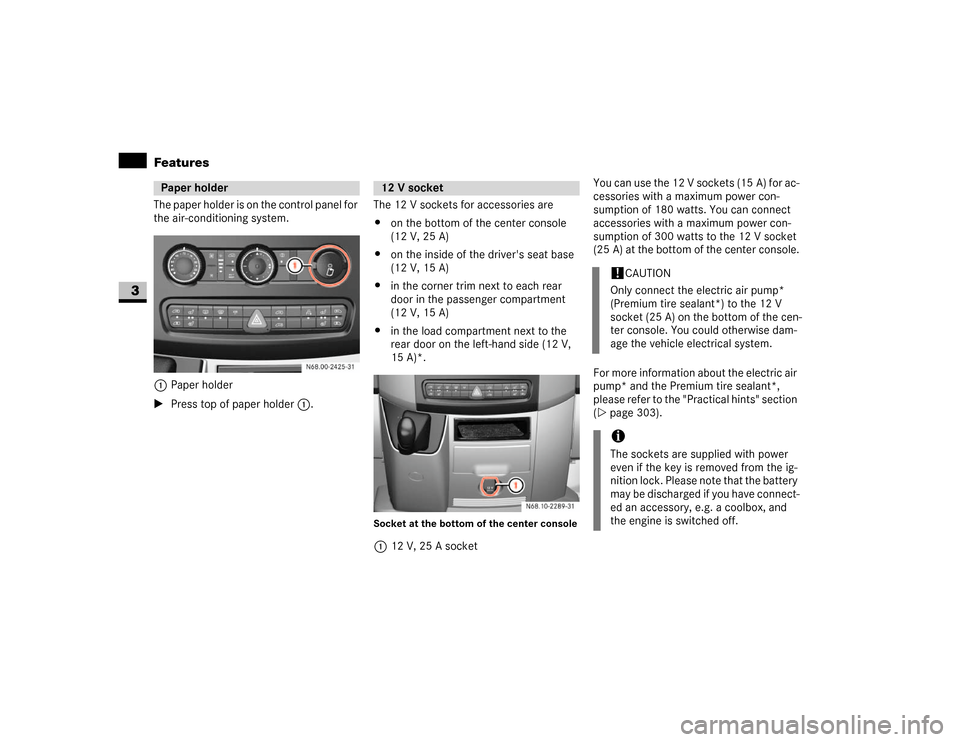
170 Controls in detailFeatures
3
The paper holder is on the control panel for
the air-conditioning system. 1Paper holder
\1Press top of paper holder1.The 12 V sockets for accessories are
\4on the bottom of the center console
(12 V, 25 A)
\4on the inside of the driver's seat base
(12 V, 15 A)
\4in the corner trim next to each rear
door in the passenger compartment
(12 V, 15 A)
\4in the load compartment next to the
rear door on the left-hand side (12 V,
15 A)*.
Socket at the bottom of the center console112 V, 25 A socketYou can use the 12 V sockets (15 A) for ac-
cessories with a maximum power con-
sumption of 180 watts. You can connect
accessories with a maximum power con-
sumption of 300 watts to the 12 V socket
(25 A) at the bottom of the center console.
For more information about the electric air
pump* and the Premium tire sealant*,
please refer to the "Practical hints" section
(\2page 303).
Paper holder
N68.00-2425-31
12 V socket
!
CAUTION
Only connect the electric air pump*
(Premium tire sealant*) to the 12 V
socket (25 A) on the bottom of the cen-
ter console. You could otherwise dam-
age the vehicle electrical system.
iThe sockets are supplied with power
even if the key is removed from the ig-
nition lock. Please note that the battery
may be discharged if you have connect-
ed an accessory, e.g. a coolbox, and
the engine is switched off.
Page 172 of 393
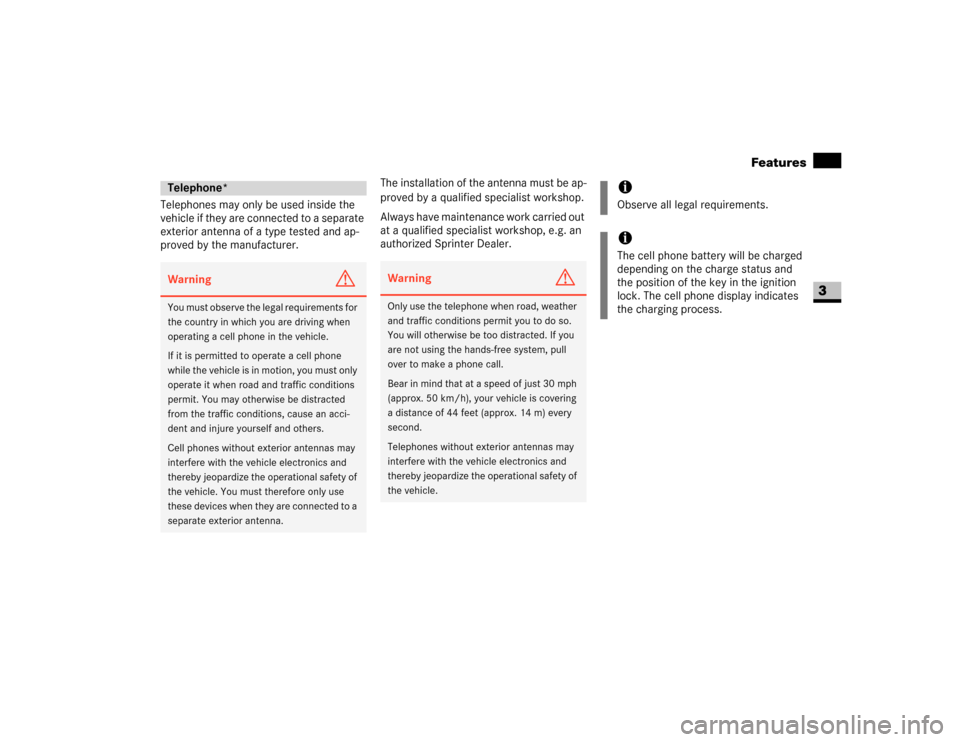
171 Controls in detail
Features
3
Telephones may only be used inside the
vehicle if they are connected to a separate
exterior antenna of a type tested and ap-
proved by the manufacturer.The installation of the antenna must be ap-
proved by a qualified specialist workshop.
Always have maintenance work carried out
at a qualified specialist workshop, e.g. an
authorized Sprinter Dealer.Telephone*Warning
G
You must observe the legal requirements for
the country in which you are driving when
operating a cell phone in the vehicle.
If it is permitted to operate a cell phone
while the vehicle is in motion, you must only
operate it when road and traffic conditions
permit. You may otherwise be distracted
from the traffic conditions, cause an acci-
dent and injure yourself and others.
Cell phones without exterior antennas may
interfere with the vehicle electronics and
thereby jeopardize the operational safety of
the vehicle. You must therefore only use
these devices when they are connected to a
separate exterior antenna.
Warning
G
Only use the telephone when road, weather
and traffic conditions permit you to do so.
You will otherwise be too distracted. If you
are not using the hands-free system, pull
over to make a phone call.
Bear in mind that at a speed of just 30 mph
(approx. 50 km/h), your vehicle is covering
a distance of 44 feet (approx. 14 m) every
second.
Telephones without exterior antennas may
interfere with the vehicle electronics and
thereby jeopardize the operational safety of
the vehicle.
iObserve all legal requirements.iThe cell phone battery will be charged
depending on the charge status and
the position of the key in the ignition
lock. The cell phone display indicates
the charging process.
Page 173 of 393

Page 174 of 393
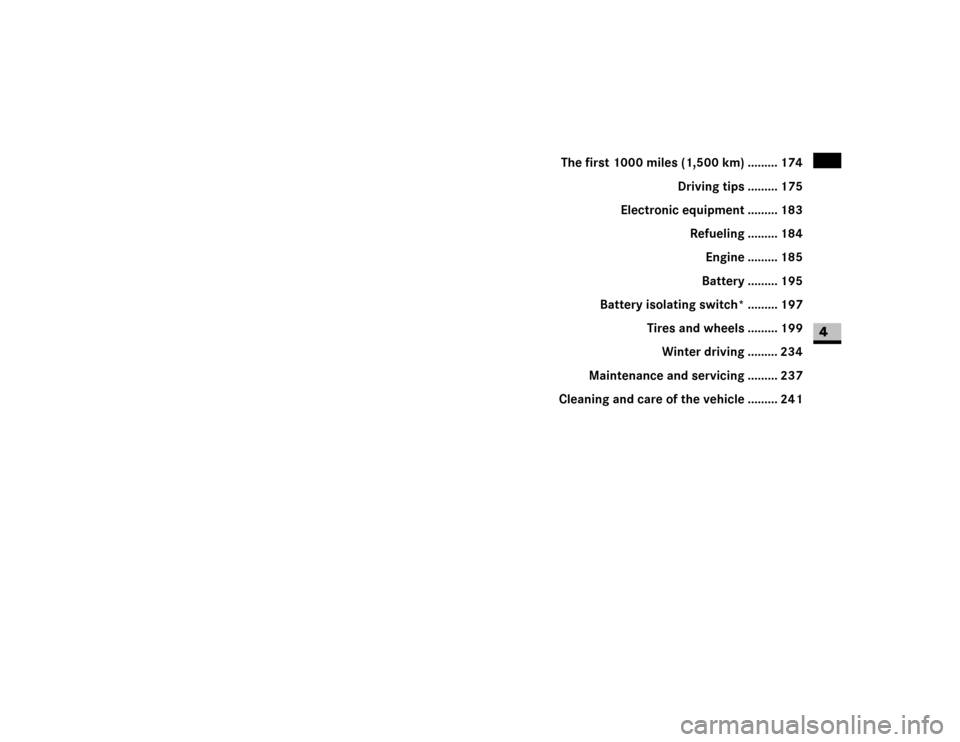
173
4 Operation
The first 1000 miles (1,500 km) ......... 174
Driving tips ......... 175
Electronic equipment ......... 183
Refueling ......... 184
Engine ......... 185
Battery ......... 195
Battery isolating switch* ......... 197
Tires and wheels ......... 199
Winter driving ......... 234
Maintenance and servicing ......... 237
Cleaning and care of the vehicle ......... 241
Page 175 of 393
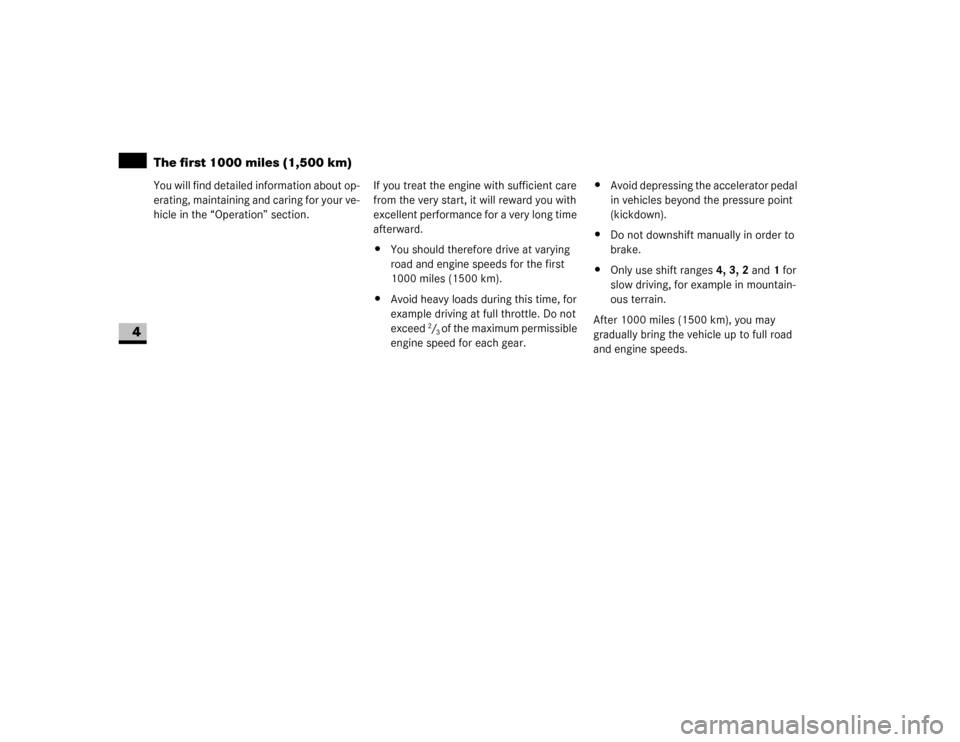
174 OperationThe first 1000 miles (1,500 km)
4
You will find detailed information about op-
erating, maintaining and caring for your ve-
hicle in the “Operation” section.If you treat the engine with sufficient care
from the very start, it will reward you with
excellent performance for a very long time
afterward.
\4You should therefore drive at varying
road and engine speeds for the first
1000 miles (1500 km).
\4Avoid heavy loads during this time, for
example driving at full throttle. Do not
exceed
2/3 of the maximum permissible
engine speed for each gear.\4Avoid depressing the accelerator pedal
in vehicles beyond the pressure point
(kickdown).
\4Do not downshift manually in order to
brake.
\4Only use shift ranges4, 3, 2 and 1 for
slow driving, for example in mountain-
ous terrain.
After 1000 miles (1500 km), you may
gradually bring the vehicle up to full road
and engine speeds.
Page 176 of 393
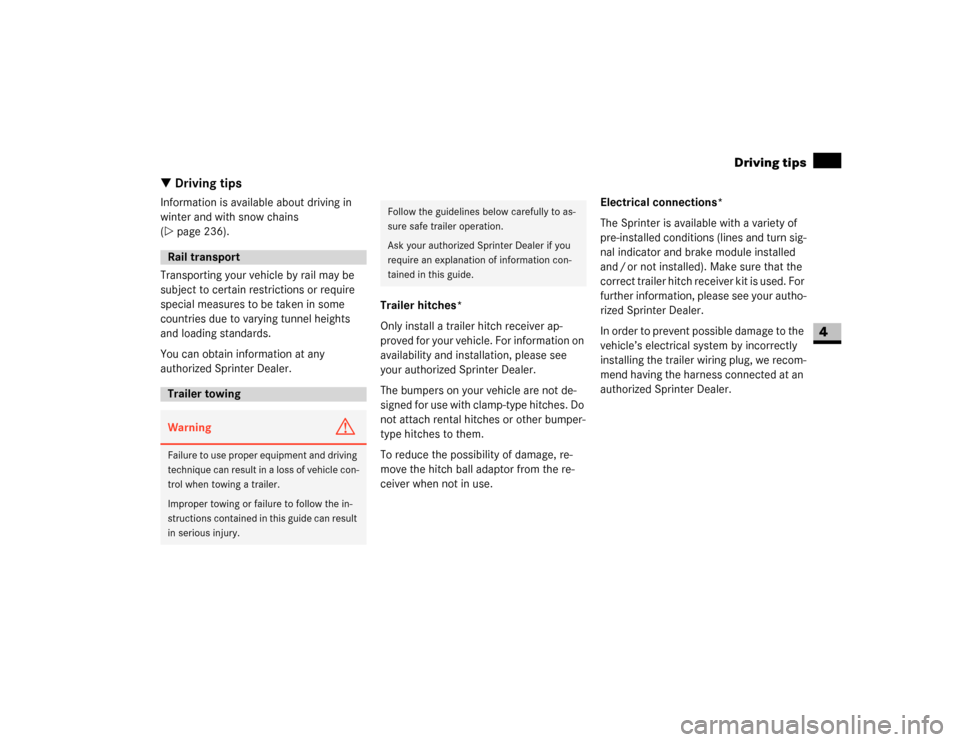
175 Operation
Driving tips
4
\3 Driving tipsInformation is available about driving in
winter and with snow chains
(\2page 236).
Transporting your vehicle by rail may be
subject to certain restrictions or require
special measures to be taken in some
countries due to varying tunnel heights
and loading standards.
You can obtain information at any
authorized Sprinter Dealer.Trailer hitches*
Only install a trailer hitch receiver ap-
proved for your vehicle. For information on
availability and installation, please see
your authorized Sprinter Dealer.
The bumpers on your vehicle are not de-
signed for use with clamp-type hitches. Do
not attach rental hitches or other bumper-
type hitches to them.
To reduce the possibility of damage, re-
move the hitch ball adaptor from the re-
ceiver when not in use.Electrical connections*
The Sprinter is available with a variety of
pre-installed conditions (lines and turn sig-
nal indicator and brake module installed
and / or not installed). Make sure that the
correct trailer hitch receiver kit is used. For
further information, please see your autho-
rized Sprinter Dealer.
In order to prevent possible damage to the
vehicle’s electrical system by incorrectly
installing the trailer wiring plug, we recom-
mend having the harness connected at an
authorized Sprinter Dealer.Rail transportTrailer towingWarning
G
Failure to use proper equipment and driving
technique can result in a loss of vehicle con-
trol when towing a trailer.
Improper towing or failure to follow the in-
structions contained in this guide can result
in serious injury.
Follow the guidelines below carefully to as-
sure safe trailer operation.
Ask your authorized Sprinter Dealer if you
require an explanation of information con-
tained in this guide.
Page 177 of 393
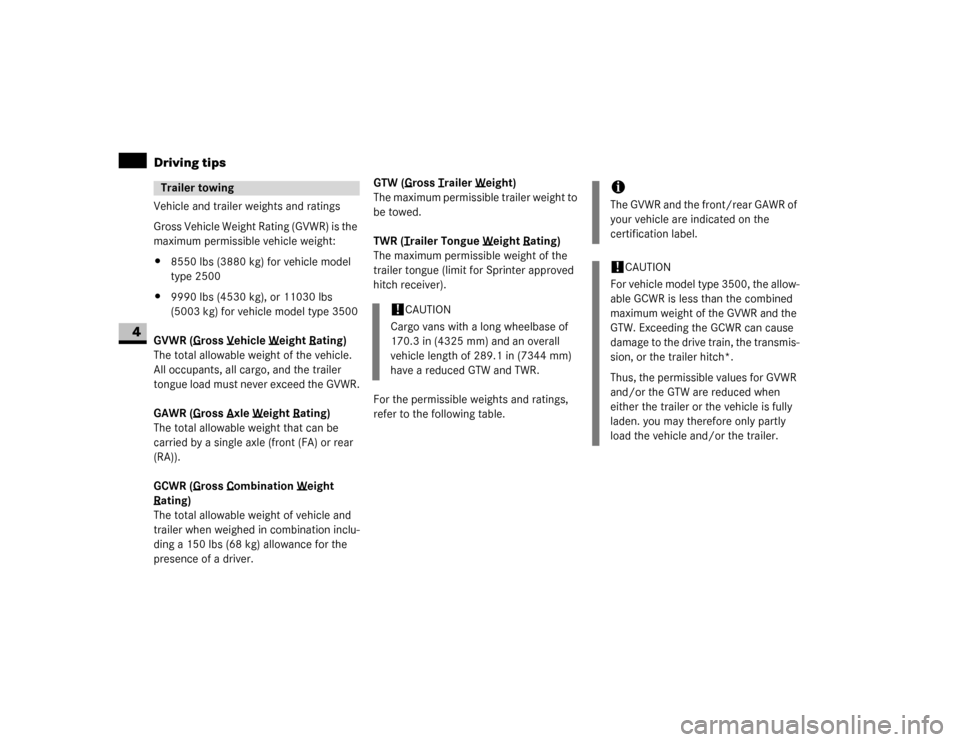
176 OperationDriving tips
4
Vehicle and trailer weights and ratings
Gross Vehicle Weight Rating (GVWR) is the
maximum permissible vehicle weight:
\48550 lbs (3880 kg) for vehicle model
type 2500
\49990 lbs (4530 kg), or 11030 lbs
(5003 kg) for vehicle model type 3500
GVWR (G
ross V
ehicle W
eight R
ating)
The total allowable weight of the vehicle.
All occupants, all cargo, and the trailer
tongue load must never exceed the GVWR.
GAWR (G
ross A
xle W
eight R
ating)
The total allowable weight that can be
carried by a single axle (front (FA) or rear
(RA)).
GCWR (G
ross C
ombination W
eight
R
ating)
The total allowable weight of vehicle and
trailer when weighed in combination inclu-
ding a 150 lbs (68 kg) allowance for the
presence of a driver.GTW (G
ross T
railer W
eight)
The maximum permissible trailer weight to
be towed.
TWR (T
railer Tongue W
eight R
ating)
The maximum permissible weight of the
trailer tongue (limit for Sprinter approved
hitch receiver).
For the permissible weights and ratings,
refer to the following table.
Trailer towing
!
CAUTION
Cargo vans with a long wheelbase of
170.3 in (4325 mm) and an overall
vehicle length of 289.1 in (7344 mm)
have a reduced GTW and TWR.
iThe GVWR and the front/rear GAWR of
your vehicle are indicated on the
certification label.!
CAUTION
For vehicle model type 3500, the allow-
able GCWR is less than the combined
maximum weight of the GVWR and the
GTW. Exceeding the GCWR can cause
damage to the drive train, the transmis-
sion, or the trailer hitch*.
Thus, the permissible values for GVWR
and/or the GTW are reduced when
either the trailer or the vehicle is fully
laden. you may therefore only partly
load the vehicle and/or the trailer.
Page 178 of 393
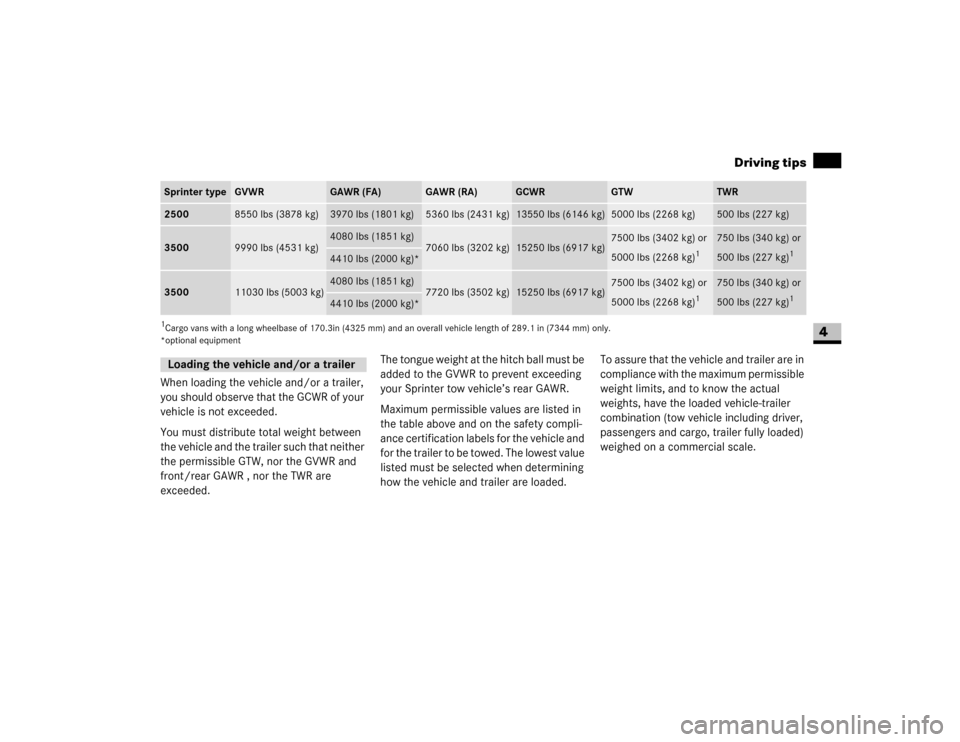
177 Operation
Driving tips
4
1Cargo vans with a long wheelbase of 170.3in (4325 mm) and an overall vehicle length of 289.1 in (7344 mm) only.
*optional equipmentWhen loading the vehicle and/or a trailer,
you should observe that the GCWR of your
vehicle is not exceeded.
You must distribute total weight between
the vehicle and the trailer such that neither
the permissible GTW, nor the GVWR and
front/rear GAWR , nor the TWR are
exceeded.The tongue weight at the hitch ball must be
added to the GVWR to prevent exceeding
your Sprinter tow vehicle’s rear GAWR.
Maximum permissible values are listed in
the table above and on the safety compli-
ance certification labels for the vehicle and
for the trailer to be towed. The lowest value
listed must be selected when determining
how the vehicle and trailer are loaded.To assure that the vehicle and trailer are in
compliance with the maximum permissible
weight limits, and to know the actual
weights, have the loaded vehicle-trailer
combination (tow vehicle including driver,
passengers and cargo, trailer fully loaded)
weighed on a commercial scale.Sprinter type
GVWR
GAWR (FA)
GAWR (RA)
GCWR
GTW
TWR
2500
8550 lbs (3878 kg)
3970 lbs (1801 kg)
5360 lbs (2431 kg)
13550 lbs (6146 kg)
5000 lbs (2268 kg)
500 lbs (227 kg)
3500
9990 lbs (4531 kg)
4080 lbs (1851 kg)
7060 lbs (3202 kg)
15250 lbs (6917 kg)
7500 lbs (3402 kg) or
5000 lbs (2268 kg)
1
750 lbs (340 kg) or
500 lbs (227 kg)
1
4410 lbs (2000 kg)*
3500
11030 lbs (5003 kg)
4080 lbs (1851 kg)
7720 lbs (3502 kg)
15250 lbs (6917 kg)
7500 lbs (3402 kg) or
5000 lbs (2268 kg)
1
750 lbs (340 kg) or
500 lbs (227 kg)
1
4410 lbs (2000 kg)*
Loading the vehicle and/or a trailer
Page 179 of 393
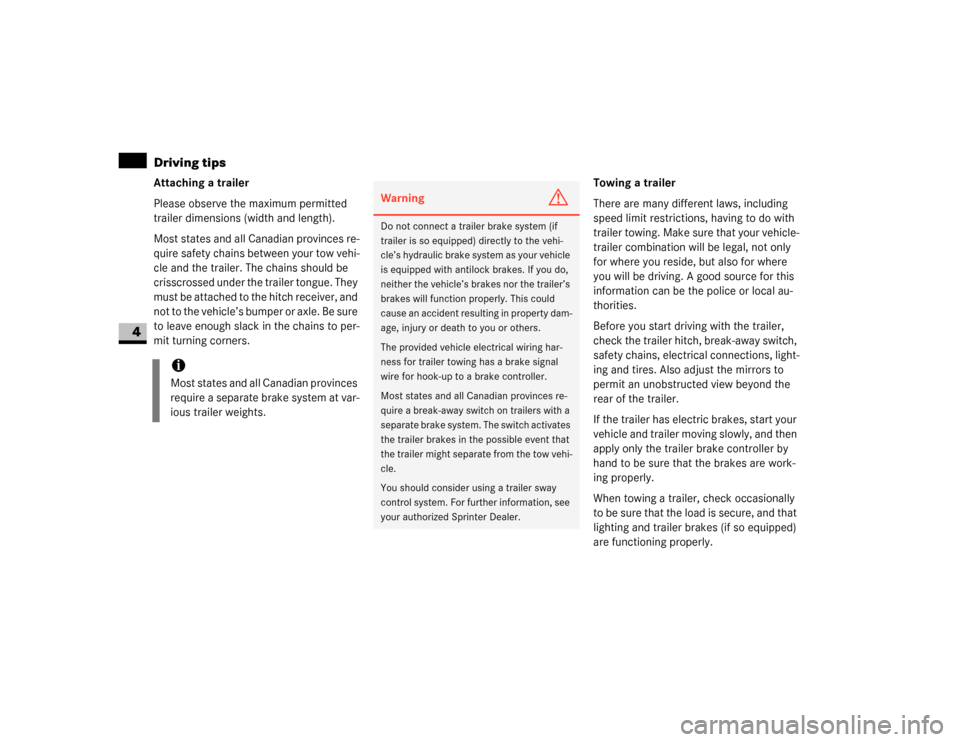
178 OperationDriving tips
4
Attaching a trailer
Please observe the maximum permitted
trailer dimensions (width and length).
Most states and all Canadian provinces re-
quire safety chains between your tow vehi-
cle and the trailer. The chains should be
crisscrossed under the trailer tongue. They
must be attached to the hitch receiver, and
not to the vehicle’s bumper or axle. Be sure
to leave enough slack in the chains to per-
mit turning corners.Towing a trailer
There are many different laws, including
speed limit restrictions, having to do with
trailer towing. Make sure that your vehicle-
trailer combination will be legal, not only
for where you reside, but also for where
you will be driving. A good source for this
information can be the police or local au-
thorities.
Before you start driving with the trailer,
check the trailer hitch, break-away switch,
safety chains, electrical connections, light-
ing and tires. Also adjust the mirrors to
permit an unobstructed view beyond the
rear of the trailer.
If the trailer has electric brakes, start your
vehicle and trailer moving slowly, and then
apply only the trailer brake controller by
hand to be sure that the brakes are work-
ing properly.
When towing a trailer, check occasionally
to be sure that the load is secure, and that
lighting and trailer brakes (if so equipped)
are functioning properly.
iMost states and all Canadian provinces
require a separate brake system at var-
ious trailer weights.
Warning
G
Do not connect a trailer brake system (if
trailer is so equipped) directly to the vehi-
cle’s hydraulic brake system as your vehicle
is equipped with antilock brakes. If you do,
neither the vehicle’s brakes nor the trailer’s
brakes will function properly. This could
cause an accident resulting in property dam-
age, injury or death to you or others.
The provided vehicle electrical wiring har-
ness for trailer towing has a brake signal
wire for hook-up to a brake controller.
Most states and all Canadian provinces re-
quire a break-away switch on trailers with a
separate brake system. The switch activates
the trailer brakes in the possible event that
the trailer might separate from the tow vehi-
cle.
You should consider using a trailer sway
control system. For further information, see
your authorized Sprinter Dealer.
Page 180 of 393
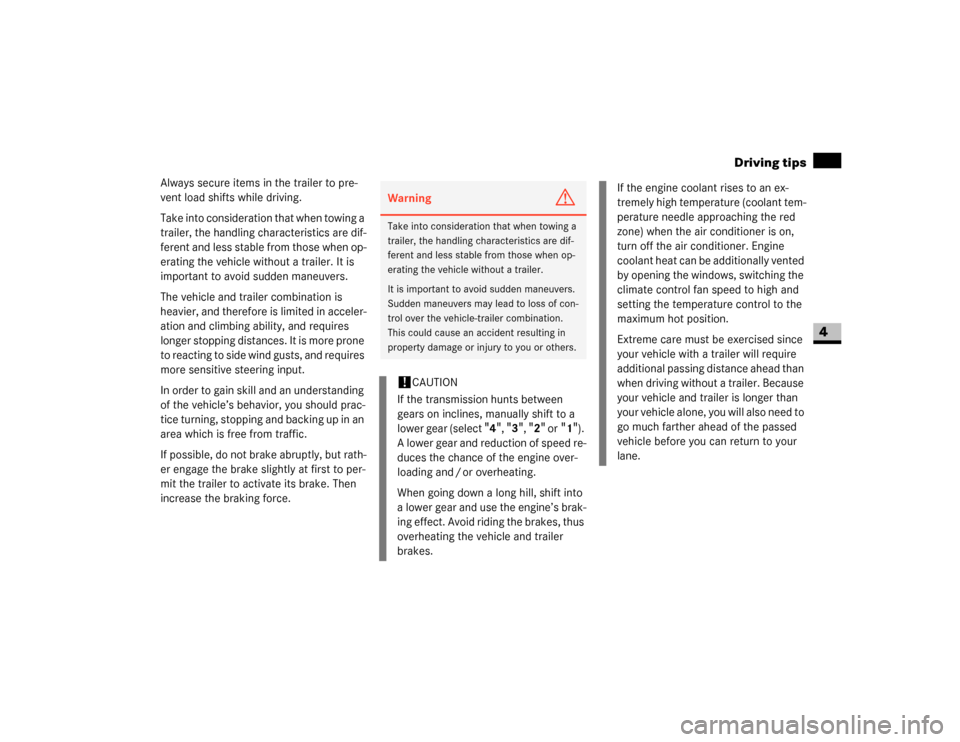
179 Operation
Driving tips
4
Always secure items in the trailer to pre-
vent load shifts while driving.
Take into consideration that when towing a
trailer, the handling characteristics are dif-
ferent and less stable from those when op-
erating the vehicle without a trailer. It is
important to avoid sudden maneuvers.
The vehicle and trailer combination is
heavier, and therefore is limited in acceler-
ation and climbing ability, and requires
longer stopping distances. It is more prone
to reacting to side wind gusts, and requires
more sensitive steering input.
In order to gain skill and an understanding
of the vehicle’s behavior, you should prac-
tice turning , st opping and backing up in a n
area which is free from traffic.
If possible, do not brake abruptly, but rath-
er engage the brake slightly at first to per-
mit the trailer to activate its brake. Then
increase the braking force.
Warning
G
Take into consideration that when towing a
trailer, the handling characteristics are dif-
ferent and less stable from those when op-
erating the vehicle without a trailer.
It is important to avoid sudden maneuvers.
Sudden maneuvers may lead to loss of con-
trol over the vehicle-trailer combination.
This could cause an accident resulting in
property damage or injury to you or others.!
CAUTION
If the transmission hunts between
gears on inclines, manually shift to a
lower gear (select
"4", "3", "2" or
"1").
A lower gear and reduction of speed re-
duces the chance of the engine over-
loading and / or overheating.
When going down a long hill, shift into
a lower gear and use the engine’s brak-
ing effect. Avoid riding the brakes, thus
overheating the vehicle and trailer
brakes.
If the engine coolant rises to an ex-
tremely high temperature (coolant tem-
perature needle approaching the red
zone) when the air conditioner is on,
turn off the air conditioner. Engine
coolant heat can be additionally vented
by opening the windows, switching the
climate control fan speed to high and
setting the temperature control to the
maximum hot position.
Extreme care must be exercised since
your vehicle with a trailer will require
additional passing distance ahead than
when driving without a trailer. Because
your vehicle and trailer is longer than
your vehicle alone, you will also need to
go much farther ahead of the passed
vehicle before you can return to your
lane.